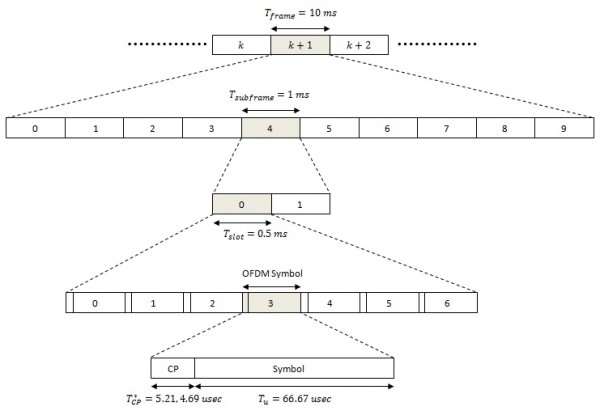Carrier phase or frequency synchronization is a common problem in wireless communication systems. These two problems are interrelated as instantaneous frequency is just the rate of change of phase. The problem of carrier frequency offset might appear due to one of two reasons. Either the oscillators at the transmitter and receiver are not aligned in the frequency domain or there is a Doppler shift introduced by the channel (remember that a moving object in the wireless environment introduces a Doppler shift). In the case of the former the frequency misalignment is given in parts per million (ppm). A typical value for commercially available oscillators is ±20 ppm. Assuming that there is maximum frequency error at both the transmitter and receiver the error increases to ±40 ppm. At 1GHz this translates to 40*1,000,000,000/1,000,000 = 40kHz.
Continue reading Modeling Phase and Frequency Synchronization ErrorTag Archives: Frequency
LTE Resource Allocation in Time-Frequency Plane
The LTE standard defines a resource allocation structure in time and frequency domains. If the spatial domain is also considered the resource allocation structure actually becomes a 3-dimensional arrangment. We will ignore the spatial domain for now and focus on the time-frequency plane.
In the time domain the LTE transmissions are organized into frames of 10 msec length. Each frame is composed of 10 subframes of 1 msec duration. Each subframe is made up of two equal sized slots of 0.5 msec each. Each slot is composed of 7 or 6 OFDM symbols depending upon whether a short or long Cyclic Prefix (CP) has been used. In the case of a short CP the CP has a duration of 5.21 usec for the first symbol and 4.69 usec for the remaining 6 symbols such that the total slot duration is 0.5 msec. For the long CP the CP has a duration of 16.67 usec for all 6 symbols. The useful symbol duration is fixed at 66.67 usec.
Short CP
1*(5.21+66.67)+6*(4.69+66.67)=500 usec
Long CP
6*(16.67+66.67)=500 usec
In the frequency domain the subcarriers are spaced at 15kHz giving a useful symbol duration of 1/15000=66.67 usec after the IFFT operation. A group of 12 subcarriers (12*15=180 kHz) over one time slot (0.5 msec) is referred to as a Resource Block (RB). With 1200 subcarriers available over a 20 MHz bandwidth the LTE transmitter has 100 RBs available over one time slot.
The smallest unit of resource is termed as the Resource Element which is composed of one subcarrier and one OFDM symbol. Thus an RB has 12×7=84 and 12×6=72 Resource Elements for short and long CP respectively.
Note:
1. The total number of subcarriers over a 20 MHz bandwidth is calculated as 20000 kHz/15 kHz = 1333 subcarriers, which is much greater than 1200. This is because all subcarriers are not used and some subcarriers act as guard carriers at the edges.
2. Longer CP is useful in environments with long delay spread.
